Henry William Poor
Henry William Poor (June 16, 1844 – April 13, 1915) was an American banker, stockbroker, and author.
Henry William Poor | |
|---|---|
 | |
| Born | June 16, 1844 Bangor, Maine |
| Died | April 13, 1915 (aged 70) New York, New York |
| Education | Harvard College |
| Occupation(s) | Banker, stockbroker, writer |
| Spouse |
Constance Evelyn Brandon
(m. 1880) |
| Children | 5 |
| Signature | |
Biography
Early life
Henry William Poor was born in Bangor, Maine in 1844, the son of Henry Varnum Poor. The family moved to New York City when he was five years old, and he spent his youth there. He attended Harvard College, graduating in 1865.[1] The firm that he and his father established in 1868, H. V. & H. W. Poor, was a predecessor to the business that eventually became Standard & Poor's.[2]
He married Constance Evelyn Brandon on February 4, 1880, and they had five children.[3]
Career
He became prominent as a stockbroker and investor, but had to liquidate his business in 1908 following some major losses.[4]
He was also widely known as a book collector and a patron of the arts.[4][5]
References
- Biography of Henry William Poor Archived July 17, 2011, at the Wayback Machine. In: Hall, Henry, ed.. America's Successful Men of Affairs: An Encyclopedia of Contemporaneous Biography, pp. 512-513. New York, USA: The New York Tribune, 1895-96.
- A History of Standard & Poor's
- The National Cyclopaedia of American Biography. Vol. XVI. James T. White & Company. 1918. pp. 33–34. Retrieved December 8, 2020 – via Google Books.
- "Henry W. Poor Fails; Loss Over a Million; Little Left of the Broker and Publisher's Once Large Fortune. Mergers Didn't Succeed; He Is Said to Have Lost Heavily In the Failure of His Sugar and Ice Investments.", The New York Times, December 27, 1908
- Henry W. Poor Dies; Railway Publisher; Head of Poor's Manual and Banker Expires Suddenly at His Home, at 71. Made and Lost a Fortune; His Wife Gave Her Big Estate to His Creditors in 1908 -- An Art and Book Collector., The New York Times, April 14, 1915
External links
- Gilding the Gilded Age: Interior Decoration Tastes & Trends in New York City A collaboration between The Frick Collection and The William Randolph Hearst Archive at LIU Post.